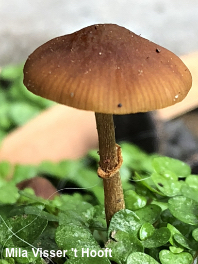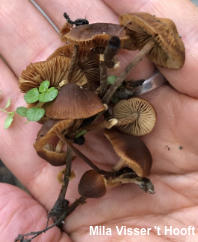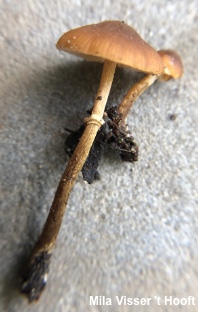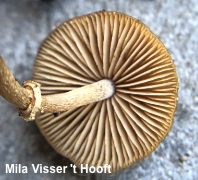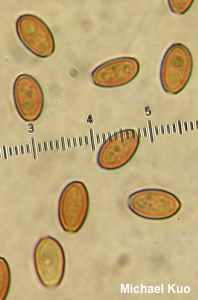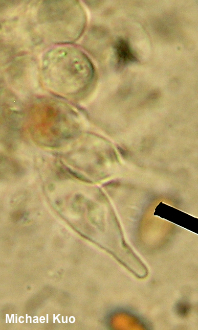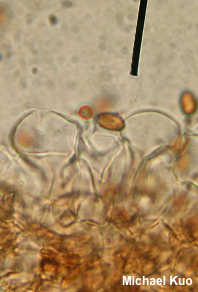| Major Groups > Gilled Mushrooms > Dark-Spored > Conocybe & Pholiotina > Pholiotina rugosa |

|
[ Basidiomycota > Agaricales > Bolbitiaceae > Pholiotina . . . ] Pholiotina rugosa by Michael Kuo, September 2020 Originally described from the Adirondack Mountains, growing on the ground "among decaying chips" (Peck 1898), this LBM (Little Brown Mushroom) is best recognized by its terrestrial habitat, its persistent pale ring, and microscopic features (see the description below). Although Pholiotina rugosa is fairly widely distributed in North America and occasionally reported from various locations, it is most likely to be found in two zones: one between the Adirondacks and Michigan, and one from northern California to Alaska. Galerina marginata is similar in appearance, but is generally larger—and it grows on fallen logs, rather than on the ground. Other Pholiotina rugosa look-alikes abound, depending on what you want to call "looking alike"; it's a little brown mushroom, after all. At a minimum, various species of Conocybe, Agrocybe, and Tubaria can look similar enough to cause confusion. Unless it was published fairly recently your field guide is likely to call this mushroom Conocybe filaris or Pholiotina filaris. Whether or not filaris and rugosa are the same species rather depends on what source you consult. If they are separate, the finely wrinkled cap of Pholiotina rugosa ("rugosa" means "wrinkled") and its slightly larger size ostensibly separate it from the smooth, slightly smaller Pholiotina filaris. However, just for giggles, note that one recent source (Læssøe & Petersen 2019) says "[t]he wrinkled cap surface is diagnostic" for Pholiotina rugosa, but describes the cap as "smooth to wrinkled." There is no HTML code for the rolls-eyes emoji, but I would employ it here if I could. Thanks to Mila Visser 't Hooft for documenting, collecting, and preserving Pholiotina rugosa for study; her collection is deposited in The Herbarium of Michael Kuo. Description: Ecology: Saprobic; growing alone or gregariously on the ground in woods or in urban locations, often in landscaping areas near woody debris; spring and summer in north-temperate climates, or over winter in Mediterranean climates; in North America distributed primarily in a zone from upstate New York to Michigan—and, especially, from northern California to Alaska; also reported from Europe and Oceania. The illustrated and described collection is from California. Cap: 1–2 cm; broadly conic to broadly bell-shaped at first, becoming broadly convex to planoconvex, sometimes with a central bump; thin; lubricous; bald; smooth, or finely wrinkled over the center; dark orangish brown centrally and yellowish brown toward the edge; margin finely lined, about halfway to the center. Gills: Narrowly attached to the stem; close; short-gills frequent; whitish becoming brownish; at first covered by a whitish partial veil. Stem: 20–35 mm long; 2–3 mm thick; fragile; equal above a slightly swollen base; brownish to brown below and whitish above; pruinose to fibrillose; with a fairly persistent, whitish to brownish, upward-flared ring that sometimes features a grooved upper edge. Flesh: Insubstantial; watery brownish; unchanging. Odor: Not distinctive. Microscopic Features: Spores 8–9 x 5–6 µm; ellipsoid; with a 1–1.5 µm pore; smooth; walls about 0.5 µm thick; bright orange-brown in KOH. Basidia 4-sterigmate; 20–25 x 6–8 µm; clavate. Pleurocystidia not found. Cheilocystidia 30–35 x 6–8 µm; lageniform, most with a fairly long neck; thin-walled; smooth; hyaline in KOH. Pileipellis hymeniform; terminal cells obpyriform; up to 25 µm across; smooth; hyaline in KOH. REFERENCES: (Peck, 1898) Singer 1948. (Smith, Smith & Weber, 1979; Watling, 1982; Arora, 1986; Phillips, 1991/2005; Lincoff, 1992; Breitenbach & Kränzlin, 1995; Barron, 1999; Hausknecht et al., 2004; Arnolds, 2005; Trudell & Ammirati, 2009; Buczacki et al., 2012; Desjardin, Wood & Stevens, 2015; Siegel & Schwarz, 2016; Gminder & Böhning, 2017; Siquier & Salom, 2017; Hausknecht & Vesterholt, 2018; Læssøe & Petersen, 2019.) Herb. Kuo 01272001. This site contains no information about the edibility or toxicity of mushrooms. |
© MushroomExpert.Com |
|
Cite this page as: Kuo, M. (2020, September). Pholiotina rugosa. Retrieved from the MushroomExpert.Com Web site: http://www.mushroomexpert.com/pholiotina_rugosa.html |
